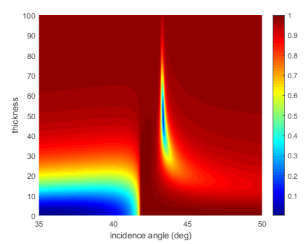Publications: Thin Films and Electromagnetic Optics

Compact formulation of the transparent–absorbing isotropic interface electromagnetic problem
Salvador Bosch, Josep Ferré-Borrull, Jordi Sancho-Parramon, and Oriol Arteaga
Journal of the Optical Society of America A Vol. 39, Issue 10, pp. 1774-1781 (2022)
A complete formulation of the electromagnetic problem corresponding to the light incidence from a transparent to an absorbing medium (isotropic materials) is developed. According to the standard separation in 𝑠 and 𝑝 polarization cases, we explicitly obtain all the relevant formulas that relate the polarization and Poynting vectors of the reflected and transmitted beams with the incident ones. Overall, the procedure is compact since it is short and complete.
https://doi.org/10.1364/JOSAA.466318
Thin film optics computations in a high-level programming language environment: tutorial
Salvador Bosch, Josep Ferré-Borrull, Jordi Sancho-Parramon
arXiv preprint arXiv:2206.07003
Thin film technology is a most relevant field in terms of number of different applications and, even more, in how widespread the use of the technology is. Virtually all optical devices involving light beams or with imaging capabilities available on the market contain thin film assemblies that are crucial for enhancing the practical performances of the device. So, nowadays, thin film coatings are routinely deposited on very different kinds of substrates. From the beginning, the use of thin films required the optical characterization of the coating materials as well as the design of the suitable thin film structures in order to meet the optical requirements. This has been a significant research topic in the past but the impact of high level programming languages has dramatically changed the scenario. Nowadays, to address the more advanced computation tasks related to thin film technology is much simple. The aim of the Tutorial presented here is to enable the reader (with only a basic knowledge of the use of Matlab or Python) to perform advanced numerical computations of the optical properties of thin film structures. We will explain the necessary steps and supply the corresponding program codes, with complete comments. For conciseness, our short theoretical introduction will follow the scheme established elsewhere and we will concentrate on developing in detail several practical examples of increasing difficulty, so that understanding and using the Tutorial becomes entirely intuitive.
https://arxiv.org/abs/2206.07003
Research funded by Ministerio de Ciencia e Innovación, Spain MCIN/AEI / 10.13039/501100011033
- Grant PID2022-136796OB-I00
- Grant PID2019-104268GB-C22
